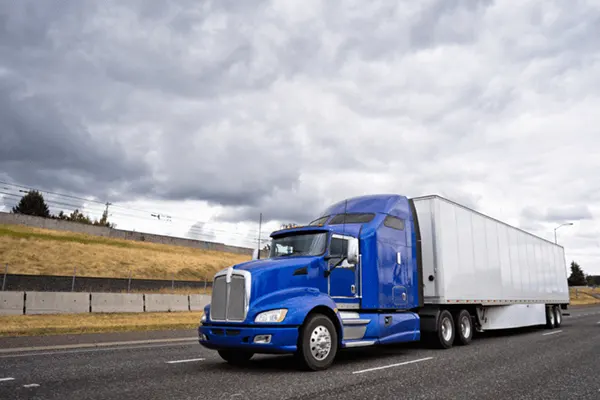
The Importance of Truck Trip Planning: How to Map the Best Routes and Avoid Delays
Picture this: You’re behind the wheel, clock ticking, only to hit an unexpected low bridge closure or get stuck in gridlock traffic not shown on your standard map app. These aren’t just annoyances; they’re costly delays impacting your bottom line and delivery schedule. This is where meticulous truck trip planning becomes your most valuable co-pilot.
What is truck trip planning? It’s the strategic process of mapping a commercial truck’s journey, looking far beyond just the shortest distance. Effective planning considers safety, efficiency, compliance, and unique truck requirements to ensure every mile counts. In today’s demanding trucking and logistics landscape, robust trip planning isn’t optional — it’s essential for maintaining profitability, ensuring safety on the road, and meeting strict compliance regulations.
This guide will delve into the crucial benefits of trip planning, break down the key elements involved, offer a step-by-step approach to mapping the best routes, explore helpful technology, share tips for avoiding common delays, reveal a unique planning insight, and answer common questions. Let’s master those miles together.
Tangible Benefits of Prioritizing Truck Trip Planning
Investing time upfront in thorough trip planning isn’t just about ticking a box; it delivers concrete advantages that impact safety, efficiency, and your bottom line. Effective trip planning yields significant advantages for drivers, owner-operators, and fleet managers alike.
Enhanced Safety: Proactive planning allows you to identify and route around potential hazards before the wheels start rolling. This includes pinpointing low clearance bridges, avoiding steep grades unsuitable for heavy loads, navigating away from known dangerous intersections, and factoring in adverse weather conditions along the route. Ultimately, better planning leads directly to safer driving.
Maximized Efficiency: Wasted miles and excessive idling burn fuel and time. Smart trip planning optimizes routes not just for distance but for overall efficiency, considering factors like traffic patterns and road types to reduce unnecessary driving, minimize costly idling, and significantly improve fuel consumption. This translates to real savings and faster turnarounds.
Guaranteed Compliance: Staying compliant is non-negotiable. Trip planning is crucial for ensuring adherence to complex Hours of Service (HOS) regulations mandated by the FMCSA, by accurately calculating driving time and scheduling required breaks. It also ensures the chosen route complies with specific restrictions related to weight, dimensions, or hazardous materials, avoiding hefty fines and violations.
Improved Profitability: Lower costs and better time management directly boost profitability. By optimizing for fuel efficiency, reducing wear-and-tear through better routes, avoiding compliance fines, and maximizing the number of loads hauled through efficient scheduling, effective trip planning makes trucking operations more lucrative.
Reduced Driver Stress and Fatigue: Uncertainty breeds stress. Providing drivers with a well-researched, achievable plan that includes predictable break times and pre-identified safe parking locations significantly reduces anxiety. Knowing the route is vetted and HOS is accounted for allows drivers to focus on driving safely, combating fatigue and improving overall well-being and retention.
Core Components of Effective Truck Trip Planning
Successful and professional truck trip planning goes far beyond simply plugging addresses into a GPS. It involves a multi-faceted evaluation of critical factors that ensure a smooth, safe, and compliant journey. Here are the core components you need to consider.
Route Selection: Beyond Shortest or Fastest
Choosing the right path is paramount. This involves more than just finding the quickest or shortest mileage option. Effective route optimization means selecting legally permissible STAA routes (Surface Transportation Assistance Act designated highways) and considering the suitability of road types (major highways vs. secondary roads with potential hazards). The goal is to find the truly most efficient route by balancing travel time, fuel costs, potential tolls, and overall safety for commercial vehicle routing.
Hours of Service (HOS) Integration
Compliance with HOS regulations, enforced by the FMCSA, is non-negotiable. Your trip plan must accurately calculate driving time segments, factoring in mandatory rest breaks and ensuring sufficient time for required off-duty periods, including overnight stops. Leveraging ELD Mandate data predictively helps ensure drivers have available hours to complete the planned segments legally. Effective break planning is integral to HOS compliance.
Load-Specific Considerations
Not all cargo is created equal, and neither are the routes it can travel. Planners must account for the specific load being hauled. This includes verifying the route against weight restrictions on roads and bridges (bridge laws), ensuring adequate clearance for bridge height and width, adhering to specific hazmat routing regulations if applicable, and considering any temperature control requirements for sensitive freight. Proper load securement also starts with knowing the demands the route will place on the cargo. Obtaining necessary overweight permits must be part of the plan if needed.
Fuel Strategy & Cost Management
Fuel is one of the largest variable costs in trucking. A smart trip plan includes a fuel optimization strategy. This means identifying the most advantageous fuel stops along the planned route, considering factors like fuel price, fleet network discounts, available amenities, and minimizing out-of-route miles to reach the pump. Proper planning also aids in accurate IFTA (International Fuel Tax Agreement) reporting. Strategic truck stop planning is key to managing fuel costs effectively.
Real-Time Data: Weather & Traffic
Conditions on the road are dynamic. Effective planning incorporates monitoring of real-time information. This includes checking current and forecasted weather conditions (like snow, ice, high winds, or flooding that necessitate weather routing adjustments) and utilizing real-time traffic updates to anticipate and navigate around accidents, congestion, and construction zones. Employing predictive analytics based on this data can help avoid significant delays.
Safe & Secure Parking
Finding safe and available parking, especially overnight, is a major challenge (truck parking shortage). Pre-planning reliable locations for required HOS breaks and overnight stops is crucial for driver safety and compliance. This involves identifying suitable truck stops, official rest areas, or designated safe havens (like vetted customer locations), considering security, availability, and necessary amenities.
How to Map the Best Truck Routes: A Step-by-Step Guide
Creating an optimal truck route involves a systematic process that combines technology with critical verification. Follow these steps for comprehensive and reliable route planning:
Gather All Information: Start by collecting every essential detail. This includes the precise origin and destination addresses, complete load information (weight, dimensions, hazmat classification, if any, and temperature requirements), specific delivery windows or appointment times, and the specifications of the truck and trailer being used. Accuracy here prevents downstream errors.
Utilize Truck-Specific Tools: This is crucial. Employ commercial-grade GPS navigation systems or specialized truck routing software. What tools are needed for truck routing? Truck-specific GPS and routing software are essential as they factor in commercial vehicle restrictions like height, weight, length, and hazmat regulations ⎯ details that standard car GPS systems completely ignore. Using the wrong tool can lead you into dangerous or illegal situations.
Generate and Review Initial Route(s): Input the collected information into your truck-specific routing tool. Critically review the suggested route(s). Don’t automatically accept the first option; often, tools provide alternatives prioritizing speed, shortest distance, or tolls. Compare these options and consider which best aligns with your priorities (e.g., fuel efficiency, safety, avoiding tolls).
Verify Critical Points: Technology is helpful, but manual verification adds a vital layer of safety and reliability. Double-check key segments of the proposed route using trusted external sources. Consult state Department of Transportation (DOT) websites (like 511 services) for real-time construction updates, check weather service forecasts for adverse conditions, and use satellite views or specific databases to confirm low clearances or weight-restricted bridges that the software might miss or have outdated information on.
Integrate HOS and Stops: Layer your Hours of Service (HOS) requirements onto the verified route. Plan mandatory rest breaks, strategic fuel stops (considering price and convenience), and secure overnight parking locations. Ensure that the driving time estimated for each segment is realistic and allows the driver to remain fully compliant with HOS regulations throughout the trip.
Identify Contingencies: Prepare for the unexpected. Identify potential alternative routes around known bottlenecks or major interchanges. Note safe havens or accessible truck stops along the way where a driver could safely pull over in case of sudden severe weather, unexpected road closures, or significant accidents that cause major delays.
Communicate and Finalize: Once the plan is complete and verified, ensure clear communication. If dispatching, share the detailed route plan, including all planned stops and contingency notes, with the driver. If planning for yourself, finalize your plan and ensure you have all necessary information readily accessible. Confirm understanding of critical points and backup options.
Leveraging Technology for Smarter Trip Planning
In today’s fast-paced logistics environment, technology is indispensable for efficient and effective truck trip planning. Leveraging the right tools transforms planning from a manual chore into a data-driven strategic advantage:
Commercial GPS & Mobile Apps
Purpose-built commercial GPS devices and mobile applications are foundational tools. Unlike standard navigation apps, they provide turn-by-turn directions calculated specifically based on truck attributes (height, weight, length, hazmat). They often include crucial real-time traffic updates, highlight upcoming weigh stations, locate truck stops with specific amenities, and alert drivers to truck-specific hazards, making navigation safer and more efficient.
Transportation Management Systems (TMS)
For fleet operations, Transportation Management Systems (TMS) offer a powerful, integrated platform. A TMS often combines routing capabilities with comprehensive load management, dispatching functions, automated HOS tracking, and detailed cost analysis. This allows for sophisticated optimization at the fleet level, ensuring that trip planning aligns with broader business objectives, load profitability, and asset utilization goals.
Real-Time Data Feeds
Dynamic conditions require dynamic data. Specialized services provide real-time data feeds that are crucial for proactive planning and en route adjustments. Access to live traffic information, detailed weather overlays (including radar and alerts), road closure notifications, and even predictive analytics based on historical data and current trends helps dispatchers and drivers anticipate potential delays and reroute proactively.
ELD Integration
Data from Electronic Logging Devices (ELDs) is increasingly integrated into planning processes. ELDs automatically track driver HOS, providing accurate, real-time visibility into available driving time. Integrating this data with routing and dispatch software allows for more precise planning of trip segments, helps automate compliance checks, and provides realistic time estimates for trip completion based on actual driver availability.
Predictive Power of Historical Data & Driver Feedback
While real-time traffic data and sophisticated GPS tools are invaluable, relying solely on them means missing out on a powerful, often untapped resource: the combined wisdom of past experience and on-the-ground driver knowledge. Many standard planning processes focus heavily on current conditions, but looking backward can significantly improve future performance.
Leveraging Past Trips for Future Gains
Don’t let valuable trip data disappear after delivery. Analyzing historical performance on recurring lanes provides critical insights. Compare planned trip times versus actual travel times, identify consistently problematic delay spots (even minor ones), track actual fuel consumption on specific routes, and note which “optimized” routes consistently underperform. This data analysis, whether done through a TMS or careful logbook review, helps refine baseline assumptions for future plans, making them far more realistic and efficient.
Systematizing Driver Feedback
Your drivers are your eyes and ears on the road, possessing invaluable driver knowledge that algorithms alone lack. Create a simple, consistent feedback loop for drivers to report issues not yet captured by technology. This could include:
- Newly weight-restricted roads or low bridges not updated in GPS.
- Consistently difficult or time-consuming shipper/receiver locations.
- Reliable vs. unreliable rest stops (regarding safety, parking availability, or amenities).
- Unofficial detours or shortcuts that proved effective (and legal).
The Competitive Edge: Building Operational Intelligence
The true edge comes from integrating these elements. When you combine cutting-edge real-time technology with insightful historical data analysis and structured, actionable driver feedback, you move beyond simple routing and start building true operational intelligence. This holistic approach creates a more robust, predictive, and resilient trip planning process — one that anticipates challenges standard methods might overlook and fosters continuous improvement in your operations.
Conclusion: Driving Success Through Smart Planning
Ultimately, effective truck trip planning is not just a preliminary task; it’s a foundational pillar supporting safe, compliant, and profitable trucking operations. Mastering your miles requires more than just following a GPS line.
As we’ve explored, true success lies in a strategic blend: leveraging the right technology, maintaining a firm grasp of regulations like HOS, proactively anticipating and mitigating challenges like delays, and crucially, tapping into the power of experience, both through analyzing historical data and valuing driver feedback.
We encourage you to evaluate your current planning processes. Implement these strategies, integrate driver insights, and utilize the available tools to ensure every journey is optimized for safety, efficiency, and success on the road.
Frequently Asked Questions (FAQ)
What’s the difference between truck routing and regular GPS routing?
A: Truck routing specifically considers commercial vehicle limitations like height, weight, length, and hazmat restrictions, directing trucks onto legal and safe roads. Regular GPS (like for cars) does not account for these, potentially leading to dangerous situations or fines.
How often should a trip plan be reviewed or updated?
A: A trip plan should be reviewed before departure and monitored throughout the journey. Updates may be necessary based on real-time changes in traffic, weather, HOS availability, or instructions from dispatch/customer.
Can effective trip planning really save fuel?
A: Yes, significantly. Optimizing routes to avoid unnecessary miles, steep grades, heavy traffic, and planning fuel stops strategically based on price can lead to substantial fuel savings over time.
Is relying solely on a GPS app enough for trip planning?
A: While helpful, relying solely on a GPS app isn’t sufficient. Drivers/dispatchers should cross-reference routes with other sources (DOT sites, weather reports), consider HOS, plan fuel/rest stops, and use their experience, especially in unfamiliar areas.
Please fill out the information below and our team will reach out to chat about your options.


